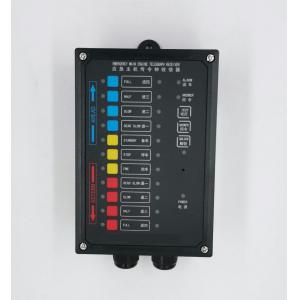

Add to Cart
Marine Main Engine Telegraph System Single Engine Telegraph Transmitter CCS Cert
| Power Supply: | AC220V (110V-240V) /0.2A |
| DC24V(18V-36V)/1A . | |
| Environment Temperature: | -10C ~ +55C |
| Relative Humidity: | < RH95% |
| Passive contacts for alarm output with the capacity of AC250V/1A or DC36V/1A . | |
| With measures against vibration, humidity, salt fog and mildew. |
| No. | Name | Model | Weight | IP class |
| 1 | Double engine telegraph transmitter | CL-2T | 0.8kg | IP20 |
| 2 | single engine telegraph transmitter | CL-T | 0.45kg | IP20 |
| 3 | engine telegraph transmitter | CL-R | 0.65kg | IP44 |
| 4 | double engine telegraph repeater | CL-2F | 0.8kg | IP20 |
| 5 | single engine telegraph repeater | CL-F | 0.45kg | IP20 |
| 6 | Wheel house unit | YK-D | 0.85kg | IP22 |
| 7 | Audible and visual alarm unit | FR-2Z | 0.6kg | IP44 |
The Telegraph System CL series is designed for sending and answering rotation rate and execution status of the main engine between wheelhouse and engine room. Adopted the microprocessor technology, the telegraph features with easy operation and cable-saving. It's a good choice for all kinds of vessels as main engine telegraph and spare engine telegraph.
Function:
1. Gear Position
CL series telegraph has 11 gear positions:Full, Half, Slow, Dead
slow, Standby, Stop, Fin, Dead slow, Slow, Half, Full. Once the
transmitter didn't synchronize with the receiver, the light flashes
along with the alarming sound. If synchronized, the lights are
always on.
2. Power failure alarm
If the main power (AC220V) failed, it will automatically turn to
DC24V along with audible and visual alarm and closing contact
output. Once the main power gained, alarming sound disappeared.
3. Dimmer
Press the test key more than 2s to choose the suitable light.
4. Error alarm
The alarm LED of the transmitter,receiver and repeater will flash
and the built-in buzzers will sound and output close contact when
the engine operates in the wrong way. Error corrected, the alarm
stopped.
5. Unlock key
Press unlock key first when make orders, operate within 5s
otherwise unlock again.
Press K2 key to make transmitter or receiver stay unlock.
If no answers, indicator flashes with buzzer sounding. Mute key in
transmitter can silent the buzzing.
If answer correctly, the indicator is on always without buzzing.
Generally speaking, the preparation time before the ship starts
sailing is usually between half an hour and six hours. The
preparation includes: power supply preparation; clock and car clock
calibration; rudder calibration; warm-up; preparation of each power
system; turning, rushing and test run. The purpose of the test
drive is: to check whether the starting system, commutation device,
fuel injection system, oil volume adjustment mechanism and governor
work normally.
The pilot conveys this instruction to the cabin engine operator
through the car clock. The ship's log and the engine log should
make accurate records of this process, so that the relevant
authorities can identify the facts and distinguish the
responsibility when the ship occurs. Some countries stipulate that
the time of giving the order to prepare the car is the time of
sailing, so according to the Hague Rules and other provisions, the
carrier should make the ship seaworthy at the time of giving the
order to prepare the car at the latest.
